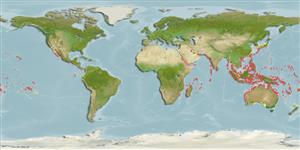Gastropoda |
Littorinimorpha |
Cypraeidae
Environment: milieu / climate zone / depth range / distribution range
Ecology
Benthic; depth range 0 - 10 m (Ref. 349). Tropical
Indo-Pacific.
Length at first maturity / Size / Weight / Age
Maturity: Lm ? range ? - ? cm Max length : 10.5 cm SHL male/unsexed; (Ref. 349); common length : 8.0 cm SHL male/unsexed; (Ref. 349)
The unusual beauty of its contrasted colour pattern makes the shell a favourite of many collectors (Ref. 349). Under slabs or in large coral heads, either on the external slope or in protected areas of the reef. Egg capsules densely laid in a big cluster about as wide as the length of the adult shell (Ref. 349).
Life cycle and mating behavior
Maturity | Reproduction | Spawning | Eggs | Fecundity | Larvae
Members of the order Neotaenioglossa are mostly gonochoric and broadcast spawners. Life cycle: Embryos develop into planktonic trocophore larvae and later into juvenile veligers before becoming fully grown adults.
Poutiers, J.M. 1998 Gastropods. p. 363-648. In Carpenter, K. E. and V. H. Niem. 1998. FAO species identification guide for fishery purposes. The living marine resources of the Western Central Pacific. Volume 1. Seaweeds, corals, bivalves, and gastropods. Rome, FAO. (Ref. 349)
IUCN Red List Status
(Ref. 130435: Version 2025-1)
CITES status (Ref. 108899)
Not Evaluated
Not Evaluated
Threat to humans
Harmless
Human uses
Fisheries: commercial
| FishSource |
Tools
More information
Trophic EcologyFood items (preys)
Diet composition
Food consumption
Predators
Population dynamicsGrowthMax. ages / sizesLength-weight rel.Length-length rel.Length-frequenciesMass conversionAbundance Life cycleReproductionMaturityFecunditySpawningEggsEgg developmentLarvae PhysiologyOxygen consumption
Human RelatedStamps, coins, misc.
Internet sources
Estimates based on models
Preferred temperature
(Ref.
115969): 24 - 29.3, mean 28.3 (based on 3398 cells).
Fishing Vulnerability
Low vulnerability (10 of 100).
Price category
Unknown.
